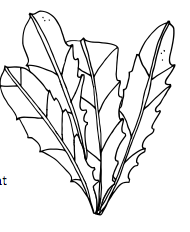How to Harvest & Eat Dandelions
Poor dandelions, always getting a bad rap for wreaking havoc on lawns and in general being a ruthless weed. It’s true that dandelions are a deeply rooted “weed” that are a real nightmare to dig out, but it’s also true that they taste pretty good and are literally everywhere. One need not look very far to find a bed of dandelions fit for eating; they are easily identifiable. Dandelion greens turn bitter and woody quite quickly, so very early spring is the best time to harvest them. To harvest and eat dandelions, try to clip the small leaves from the plant before the plant flowers.

Once the yellow flower has bloomed, taste the dandelion greens first to see if you find the flavor too off-putting. Harvest by picking off the small leaves and eating straight away. Be sure to wash dandelion greens well, and steer clear of picking them out of public lawns. Those areas are too heavily sprayed with chemicals to warrant eating. Use dandelion greens in salads, or cook them in a sauté. I like my greens wilted with a little bacon and an egg in the morning. You may also use the flower petals in recipes. I roll chopped petals into cracker or pie dough, for their bright yellow color, but the taste will not shine through unless you use an exorbitant amount of petals. If you're really brave, you can try this recipe for Dandelion Jelly & Pectin.
Lemon Trout with Dandelion Greens
Whole fish can sometimes be intimidating, but trout cooks quickly and tastes great. No need to clean anything—commercial trout comes scaled and gutted already. I learned this wholesome and healthy recipe from my friend Jaime years ago; it has been a standard of mine ever since.
Whole trout is cooked quickly under the broiler and served topped with a salad of dandelion greens and almonds. The dandelion greens are quite bitter, but work well with the subtle fish. They are also very healthy for you; ounce for ounce, they have more vitamin A, iron, and calcium than broccoli.
Harvest new dandelion growth in spring; older, bigger leaves are too tough and woody, and their flavor is harsh.

Serves 2
1 garlic clove, peeled 1 handful sliced almonds 2 handfuls dandelion greens, coarsely chopped 1 lemon, zested, then sliced 1 tablespoon olive oil Salt and freshly ground black pepper 1 whole trout
Preheat the broiler and raise a rack to the highest position in your oven.
In the bowl of a mortar and pestle, mash and grind the garlic clove. When the oils have covered the walls of the mortar, remove and discard the garlic flesh. Add the almonds to the bowl and grind until they are broken up into smaller pieces. Add the dandelion greens and lemon zest and mash all the ingredients together until com- bined. The mixture will look a little bit like a salad and a little bit like a pesto. Inconsistency in the size of the leafy bits is perfect. Add the olive oil and a pinch of salt and give it one last stir with the pestle. Set aside.
Meanwhile, season the trout on both sides and inside the belly with salt and pepper. Insert several lemon slices into the belly of the trout. Place on a sheet pan and lightly coat the trout with a drizzle of olive oil to prevent sticking. Place the sheet pan directly under the broiler, and broil on one side until the skin starts to shrivel and char, 4 to 5 minutes. Take out the pan and flip the trout with a spatula. Return to the broiler and broil the other side until charred and cooked through, 4 to 5 minutes.
Place the broiled trout on a platter and spoon the dandelion salad over it. Serve immediately.
More Garden Recipes: Dandelions are a great green for adding to your salad, but use them sparingly so they don’t overpower the other flavors. Try making a dandelion pesto with crushed garlic and pine nuts. Dandelion greens can also be used as a filling for the Pea Vine Dumplings, which are in my book Apartment Gardening
